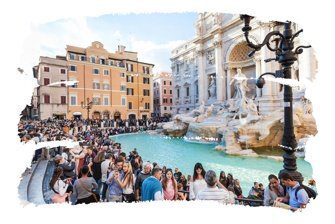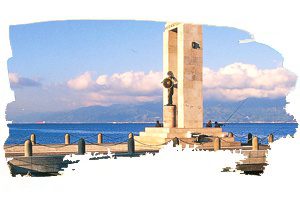How to read and understand a menu in Italian?
Italy is one of the best countries to eat around the world! With super varied options, there are dishes for all tastes (and budgets!), but do you know what to order and how to order? What if you order chicken and fish come? To prevent something like that from happening, today we are going to ‘decipher’ a basic Italian menu. Let’s go? How to read and understand a menu in Italian? Here at Your Travel to Italy with Ana Patricia you make the trip of your dreams!!! ALSO: see our “Accommodation in Italy – Tips for your holidays!” Read also: Examples of Itineraries in Italy!
About Italian Menus
People, first of all, I will explain something to you: some places, mainly in southern Italy, you will often find the menu in dialect, especially typical dishes from that region, so there is no translation of the name, but if you know the names of some ingredients, this can make the choice much easier. I say this because not all dishes have the description on the menu. Read our section on Food in Italy!
Important to Know
- If you are allergic to any food, WRITE DOWN the name of that ingredient in English and Italian and always carry it with you! When in doubt, ask the waiter if the chosen dish has its ingredient or features; after all, you don’t want to end up in the hospital for lunch, do you? To emphasize this allergy and the waiter understands, tell him that you are “estremamente allergico a …” and the name of the ingredient. DON’T RISK, O.K.?! When in doubt, order another dish! The same goes for those who are VEGAN; to say you are vegan: ‘sono vegano!’ If you are allergic to gluten, you are celiac and in Italian inform the waiter saying ‘sono celiaco’ (celiac sleep).
Good to know
- Currently, many Italian restaurants already offer menus that are totally vegan and / or adapted for celiacs, others, however, have not yet got there. There is usually a symbol at the entrance of the establishment, but if you are in doubt, ask the waiter ‘hai un menu vegano?’ Or ‘hai un menu per i celiaci?’ (say celíaci).
- Well, the Italian menu is very wide, even in the most modest places: there is the antipasto, the appetizer, main course and dessert: am I obliged to order everything? No, obviously! However, in several places the value of the Full Menu is VERY worth it! Shall we detail and understand an Italian menu now?
1) How to read and understand a menu in Italian? GET TO KNOW SOME ANTIPASTI
The most common antipasti are some cold cuts and caponatas, which are vegetables preserved in olive oil, accompanied by breads, grissini (long dough sticks), bruschetta (pieces of bread served with various toppings) and toast.
Let’s take a look:
- Cold cuts – Salumi / Salumi affumicati (cold cuts / smoked cuts);
- Cheese – formaggio (each region offers different options);
- Salami / Salamis – salume / Salumi;
- Mortadella – Mortadela;
- Ham – Prosciutto cotto or Prosciutto crudo (Di Parma);
- Sausage – Wurstel (calm down! Hahaha… it’s spoken ‘viustel’).
Tip
Salsiccia, in Italian, is fresh sausage. Normally, everything written ‘calabresa / calabrese’ has an extra dose of pepper and does not mean ‘Calabrian’! In other words, if you are not a fan of spicy foods, stay away from dishes with “calabrese” in the name! ; )
- Breads – Pani (each region offers several options);
- Toast – Fetta biscottata;
- Caponata – canned vegetables ‘sott’olio’, that is, in olive oil; there are several options, but the most common are zucchini, eggplant (melanzane) and bell peppers (peperone) which can be red (rosso), yellow (giallo) or green (green). Here, peperone is not a type of salami! 😉
People, always remember:
- Each restaurant presents the antipasto according to region, available ingredients, traditions and other factors. So it is evident that there is a difference from restaurant to restaurant and from region to region, O.K.?!
2) How to read and understand a menu in Italian? GET TO KNOW SOME APPETIZERS
For appetizers, usually (and if requested, of course!), A plate of pasta, risotto or polenta is served. Today, it is estimated that there are 300 types of Italian pasta between short pasta (penne, fusilli, etc.) and long pasta (spaghetti, taglierini, etc.). It would be impossible to list all of them, but they are all delicious and the hard part will be choosing one! Now see some pasta (the best known):
- Fusilli
- Farfalle
- Penne (watch out for the penne all’arrabbiata! It’s a pasta dipped in a SUPER spicy tomato sauce!)
- Gnochhi
- Lasagna
- Spaghetti
The Sauces
- Besciamella (bianca salsa): white sauce, bechamel; it can be simple or mixed with other ingredients such as ham, peas, cheese, etc;
- In bianco – is a pasta cooked and fried in butter;
- Burro e Salvia – the dough, after being cooked, is fried in butter with Salvia;
- Al sugo – The ‘sugo’ can be: al pomodoro (tomato), al tonno (sauce of / with tuna), sugo di carne (sauce of / with meat), etc.
Tip
When ‘sugo’ appears on the menu, it will not necessarily be tomato sauce; tomato sauce is always specified as ‘sugo al pomodoro con…’ and then the ‘complementary’ ingredient such as tuna, meat, etc., O.K.?
- Quattro formaggi – sauce with four cheeses;
- The bolognesa – another item that causes certain ‘strangeness’. In Brazil we are used to the Bolognese sauce made with tomato sauce (LOTS of sauce!), Ground beef, spices, garlic and onion. TRADITIONAL Bolognese sauce is not with as much tomato sauce as we do in Brazil! It’s ‘drier’. To start the base of the sauce, they sauté onion, garlic, celery and carrot, then add the meat and, finally, tomatoes (but not the tomato sauce, they are peeled tomatoes, without skin and without seed) and allow to be refined.
Good to know
Basic ingredients of an Italian tomato sauce: onion, garlic, salt and peeled tomatoes, without skin and without seed. Each place makes the sauce its own way, so the flavors can vary from one restaurant to another, of course!
Other Appetizers
- Rice: riso.
- Beans: fagioli.
- Filled: ripieni; goes for sweet and savory.
3) How to read and understand a menu in Italian? GET TO KNOW SOME MAIN COURSES
Let’s move on to the main course.
Meat – Meat
The meat can be medium (al punto), rare (al blood) and well done (ben cotta). The steak is called bistecca and there are differences in the preparation of the meat, which can be:
- in padella, in the pan, grilled;
- alla griglia, grilled in the best barbecue style, quickly;
- spicy, also in the style of a barbecue, but with a longer cooking time, roasted;
- arrosto, on the grill. It is one of the most time consuming, but it is worth every minute of waiting;
- Lesso, stew. The meat cooks in a broth and is very juicy and tender;
The same method of preparation applies to fish and chicken.
- Chicken – Pollo;
- Fish – Pesce.
Vegetables and the like
- Salad – insalata; insalata verde, green salad;
- Russian insalata – our beloved ‘mayonnaise’;
- Potato – patate; for french fries, just say ‘patatine’;
- Lettuce – Lattuga;
- Broccoli – Broccoli;
- Cauliflower – Cavolfiore;
- Cabbage – Cavolo;
- Oliva – Olive;
- Artichokes – Carciofi;
- Capers – Capperi;
- Carrots – Carote.
Seasoning the Salad
- Olive oil – Olio, olio d’oliva;
- Vinegar – aceto, which can also be balsamic, balsamic aceto;
- Salt – sale.
Important Tips
- Take with you, written on a piece of paper, what you like and what you don’t like to eat. Translate to Italian and, when reading the menu, don’t feel bad about having to ‘check’ your list. It is better than asking for a dish that you don’t like very much.
- Another thing: avoid asking to take ingredients from the dishes, in Italy this can be very offensive to the chef. I know that, for many, this can sound ‘picky’, some think ‘oh, but Italians are offended by everything’: people, it’s cultural! Respect the differences, especially in the house of others.
4) How to read and understand a menu in Italian? KNOW SOME DESSERTS
The desserts, i dolci, are SPECTACULAR! I always say: the Italian taste for sweets IS DIFFERENT, so Italian sweets are not so sweet, they use a lot of fruits, dark chocolate, cheeses, creams and oilseeds, like nuts.
- Chocolate – cioccolato; it can be white (bianco), milk (al latte) or bitter (amaro) with varying percentage of cocoa (cacao): the higher the percentage, the more bitter it is;
- Cream – crema; torta alla crema (cake with cream), bombolone alla crema (berliner with cream). People, the cream is the custard in these cases, but it can be another type of cream too;
- Ice cream – ice cream does not exist in Italy! HOW SO, PATRICIA? Gelato and ice cream are very different things, so the word gelato has no translation for any language. What is the difference between ice cream and gelato then? We explained everything in this post and, of course, we still list the best gelato shops for you to know exactly where to go to taste the best and authentic Italian gelato;
- Pie – torta; in Italy, torta is cake: torta alla crema, torta di limone, torta al cioccolato; but it can also designate the pies themselves;
- Fruit Salad – Macedonia; always made with seasonal fruits;
- Cookie – biscotti;
- Fruits – frutta; melon, melone; strawberry, fragola; watermelon, anguria; lemon, limone; orange, arancione; banana, banana; pineapple, ananas; apple, mela; passion fruit, frutto della passione; pomegranate, melograno; kiwi, kiwi; cherry, ciliegia; raspberry, lampone; mango, mango; peach, pesca; grape, uva;
- Cereal – cereali.
5) How to read and understand a menu in Italian? GET TO KNOW SOME DRINKS
Let’s get to drinks!
- Water – water; sparkling water – frizzante; still water, naturale;
- Ice – ghiaccio: with ice – con ghiaccio (guia-tcho); ghiacciata (guia-tchata), cold; without ice, senza ghiaccio;
- Wine – vino: rosso, red; bianco, white; sparkling, frizzante / spumantino / spumante; rosè, rosè;
- Soft Wine – Vino soave, dolce;
- Dry Wine – Vino brut, secco;
- TIP: we have a whole post dedicated to Italian wines! Haven’t you seen it yet? Click here!
- Soda – bibita (bibita); canned, lattine; it is difficult for restaurants to sell soda in a bottle, but if necessary, the bottle is bottiglia (botília). Ah, the cans are smaller, don’t be scared! The beloved Guarana is found in larger cities, like Rome, Milan … But some smaller cities may also have it. In Italian it says ‘guárâna’;
- Tea – té; chamomile, la camomilla; mint tea, té alla menta; ice tea, tè freddo; ice tea, which can be ‘alla pesca’ (peach) or al limone (with lemon);
- Juice: succo. Attention here: succo means the carton; for natural juice, ask for the spremuta, but it is very rare to find natural juice in Italy other than orange, lemon or pompelmo (grapefruit), ‘la spremuta d’arancio’, so don’t get frustrated, ok ?! They are not used to natural juices;
- Café – Caffè. In Italy, in restaurants, bars and restaurants, they only serve espresso. Write with S, expressed with X is something else! Hahahaha… It can be: ristretto, pure; lungo, with more water; macchiato, with a little milk, or correto, which takes half a dose of some alcoholic drink, usually grappa.
Good to know
- Italians hardly ever drink drinks other than wine (for adults) or water (for children) during meals, so don’t be surprised if you’re the only one in the restaurant to have a can of soda on the table! ; )
6) How to read and understand a menu in Italian? KNOW SOME UTENSILS
Tableware:
- Glass – bicchieri. (‘bikini’ is said);
- Cup – Tazza;
- Spoon – Cucchiaio (cuquiáio);
- Knife – coltello;
- Fork – forchetta;
- Napkin – tovagliolo (tovaliolo);
- Tablecloth – tovaglia (tovalia);
- Plate – Piatto.
7) How to read and understand a menu in Italian? GET TO KNOW SOME PIZZAS
We got to the pizzas! Pizza in Italy, although it serves two people very well, is individual. The most requested flavors are:
- Margherita – self-explanatory! Hahahaha;
- Four cheeses – quattro formaggi;
- Sausage with funghi – salsiccia and funghi (this pizza is a show!);
- Mozzarella – Mozzarela.
Good to know
- In Italy, THERE IS NO SAUSAGE PIZZA THE WAY YOU PROBABLY KNOW IN YOUR COUNTRY! In Italy, it is a pizza with pieces of ‘calabrese (called that because it comes from Calabria) SPICY sausage; but, as we said before, the sausage is the fresh one, O.K.?!
- Pizza in Italy is all or nothing: you either love it or you hate it! You may find it a little strange, as it may be quite different from yours.
Watch this video and learn: What is the average cost of a day in Italy?
Subscribe to our channel and receive more videos with information and tips about Italy. Don’t forget to leave that Like;)
Conclusion
How to read and understand a menu in Italian? People, I reinforce: take a short list, in Italian, on a piece of paper, of a short list of what you like to eat so you don’t run the risk of asking for something that you don’t like, O.K.? Don’t be in a hurry to eat, the Italians make meal times a real ritual, so the waiters will not stand by the table ‘rushing’ you.
If you feel insecure or have no time, and need help to organize your trip, do not hesitate to look for me! I will love to help you make your dream trip to Italy. And how can I do that? Continue reading this post until the end and you will understand how can we make your life and journey easier .
Did my post help you? If yes, make sure to leave your comment below, but if you still have questions, just leave them as a comment below and I will reply, O.K.?
An Extra Help for your Trip
The best content from Your Travel to Italy!
Learn more about our tours in Italy right now!
- What to visit in Italy in 10 days?
- The ten must-see places in Tuscany?
- The best tips to save on your trip to Italy?
- What are the 10 most visited cities in southern Italy?
- Airports in Italy? How to get to your hotel? (Venice, Milan, Rome, Florence)
- What to do in 1/2/3/4 days in the main Italian cities?
- The best tips on food in Italy (wines, typical food, enogastronomy tours)
- How to get from Fiumicino Airport to Rome downtown?
- Your Travel to Italy: 10 tips for traveling through Italy!
Best regards from Italy






 Save money!
Save money!